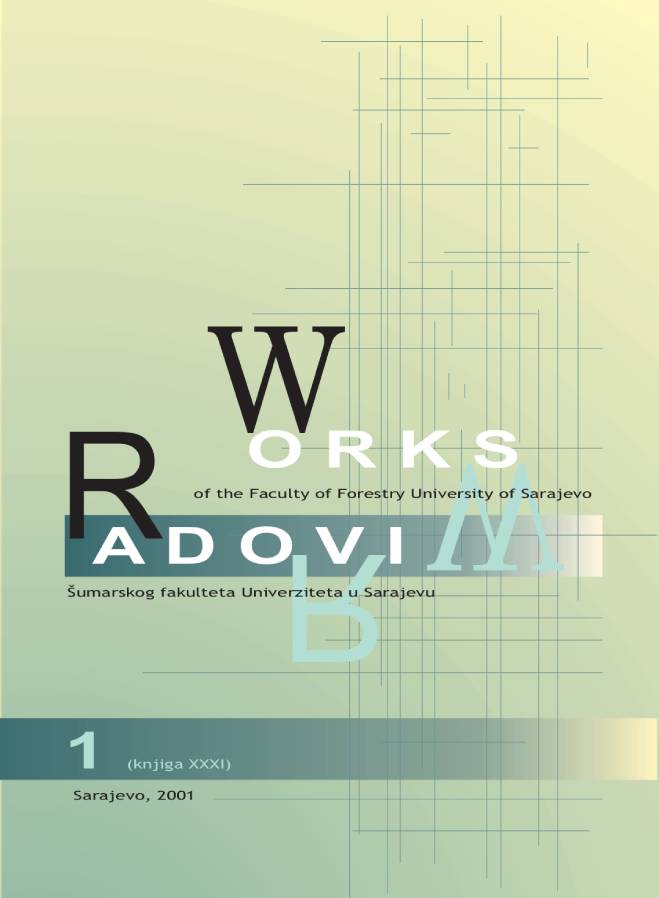Use of aggregate pheromones in control of spruce bark beetles (Scolytidae) in Bosnia-Herzegovina
DOI:
https://doi.org/10.54652/rsf.2001.v31.i1.228Keywords:
Ips typographus, Pityogenes chalcographus, aggregate pheromones, pheromone trapsAbstract
Spruce bark beetles Ips typographus L. and Pityogenes chalcographus L. are
the most important harmful scolytids in the coniferous forests of Bosnia-Herzegovina.
These destructive pests affect the area of 31.355 hectares of Bosnian territory. The mass trapping of bark beetles using pheromone baited traps in forestry practice of Bosnia-Herzegovina started 1984. The trials conducted in 1999 and 2000 showed that
both of scolytids are above critical threshold due to favorable site conditions in previous years (dry weather conditions, forest fires, lack of forest hygiene, etc). The best trap-pheromone combination for I. typographus trapping appears to be the Pheroprax/Theysohn (24% of total caught), followed with Pheroprax/Ecotrap II (16% of total caught). The lowest caught was achieved by PVC "home made" pipe trap.
Downloads
References
Babuder, G. i ostali (1996): Selectivity of syntetic aggregation pheromones Linoprax® and Pheroprax® in the control of bark beetles (Coleóptera, Scolytidae) in a timber storage yard. J. appl. Ent. 120, 131-136.
Bakke, A. (1982): Mass trapping of the spruce bark beetle Ips typographic in Noway as part of an integrated control program. Insect Suppression with Controlled Release pheromone Systems II, CRC Press, Boca Raton, FL, 17-25.
Bakke, A. (1985): Deploying pheromone-baited traps for monitoring I/?s typograpirns populations. Z. ang. Ent. 99, 33-39.
Bakke, A. (1989): The recent Ips typographus outbreak in Norway - experiences from control program. Hoi. Ecol., 12(4), 514-519.
Christiansen, E. & Bakke, A. (1988): The spruce bark beetle of Eurasia, Dynamics of Forest Insect Populations Patterns, Causes, Implications, by Berryman, Alan. A. (Editor), Plenum Press, New York and London.
Dautbašlć, M. (1997): Praćenje pojave i jačine rasprostranjenosti potkornjaka (Coleóptera: Scolytidae) na smrči sa feromonima. Magistarski rad, Šumarski fakultet u Sarajevu.
Dautbašić, M. (2000): Uticaj štetnih insekata na stabilnost šumskih ekosistema u (Coleóptera: Scolytidae) na smrči sa feromonima, Magistarski rad, Šumarski fakultet u Sarajevu.
Dautbašić, M. (2000): Uticaj štetnih insekata na stabilnost šumskih ekosistema u BiH, Savjetovanje "Obnova i održivi razvoj. Tuzla, Zbornik rezimea.
Dimitri. L. i ostali (1992): Influence of mass trapping on the population dynamic and damage-effect of bark beetles. J. Appl. Ent. 114, 103-109.
Faruta, 1., i ostali. (1984): A trial of mass trapping of Ips typographies japónicas Nijima after an extensive wind damage in Hokkaido. Appl. Entomol. Zool., 19 (4), 518-519.
Gavrilović, D. & Korpič, M. (1992): Primjena agregacionih feromona za kontrolu i suzbijanje potkomjaka i drvenara u Bosni i Hercegovini, Glasnik Šumarskog fakulteta u Beogradu br. 74, knjiga I, 89-95.
Georgijević E. (1962): O uticaju nadmorske visine i ekspozicije na pojavu Ips typographies L., Radovi Šumarskog fakulteta i Instituta za šumarstvo u Sarajevu, br:7,
Merker, E. (1957): Die oekologischen Ursachen der Massenvermehrung des grossen Fichtenborkenkäfers in Südwestdeutschland. Freiburg.
Meseldžija, P. (2000): Spriječena ekološka katastrofa, Šume, br. 60, Srbijašume, Beograd
Niemeyer, N. (1992): Monitoring Ips typographies and Pityogenes ehaleographus (Col., Scolytidae) in Lower Saxony and Schleswig-Holstein, J.Appl.Ent. 114, 98- 102,
Pfefer, A. (1995): Zentral und westpaläartische Borken und Kernkäfer, Pro Entomología, Naturhistorisches Museum Basel, Basel;
Raty, L. i ostali (1995):Mass trapping of the spruce bark beetle Ips typographus L.: traps or trap trees? Forest Ecology and Management 78, 191-205.
Renwick, A.A. (1992): New directions in semiochemical research, J. Appl. Ent. 114, 421-438.
Titovšek, J. (1988): Podlubniki Slovenije: obvladovanje podlubnikov, Zveza društev inženirjev in tehnikov gozdarstva in lesarstva Slovenije: Gozdarska založba, Ljubljana;
Švestka, M. i ostali (1998): Praktické metody v ochrane lesa, Lesnicka prace, p. 37.
Usčuplić, M., Dautbašić, M.: (1998): Bolesti i štetočine koje ugrožavaju šumske ekosisteme u Bosni i Hercegovini, Radovi Šumarskog fakulteta Univerziteta u Sarajevu, 1, 19-26, Sarajevo,
Weslien, J. (1992): Effects of mass trapping on Ips typographus L. populations, J. Appl. Ent. 114, 228-232.
Zahradnik, P. (1999): Lykoirout leskly Pityogenes ehaleographus L., Lesnicka prace 3/99, I-IV, Praha,
Zar, J. H. (1996): Biostatistical Analysis. Prentice Hall International, Inc.
Zumr, V. (1995): Lykožrout smrekovy - biologie, prevence a metody boje. Matice lesnicka.






















